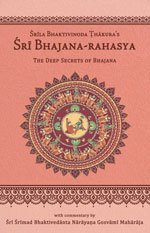Bhajana-Rahasya
by Srila Bhaktivinoda Thakura Mahasaya | 2010 | 123,965 words
The Bhajana-rahasya Text 8, English translation, including commentary (vritti). The Bhajana-rahasya is a compilation of verses describing the mercy of the eight pairs of names (Yugala-nama) of the Maha-mantra. This is text 8 belonging to the chapter “Caturtha-yama-sadhana (Madhyahna-kaliya-bhajana–ruci-bhajana)” representing from the second prahara until three-and-a-half praharas: approximately 11.00 a.m.–3.30 p.m.
Text 8
Bhakti-rasāmṛta-sindhu (1.2.115), quoting from the Padma Purāṇa, mentions the necessity of giving up distress:
शोकामर्षादिभिर् भावैर् आक्रान्तं यस्य मानसम्
कथं तत्र मुकुन्दस्य स्फूर्ति-सम्भावना भवेत्śokāmarṣādibhir bhāvair ākrāntaṃ yasya mānasam
kathaṃ tatra mukundasya sphūrti-sambhāvanā bhavetHow can Mukunda manifest in the heart of a person who is filled with lamentation, anger and so forth?
पुत्र कलत्रेर शोक, क्रोध, अभिमान
ये हृदये ताहे कृष्ण स्फूर्ति नाहि पानputra kalatrera śoka, krodha, abhimāna
ye hṛdaye tāhe kṛṣṇa sphūrti nāhi pāna
Commentary: Bhajana-rahasya-vṛtti:
Mukunda never manifests in a heart that becomes agitated by pleasure upon obtaining something temporary or distressed upon losing it. In this way, the living entity remains oblivious to Bhagavān. One should follow the character of Śrīman Mahāprabhu’s devotees and, guided by their mood, remain peaceful and steady in every situation. In this regard one should follow the example of Śrīvāsa Paṇḍita. Once Śrīman Mahāprabhu and His devotees were performing kīrtana in Śrīvāsa Paṇḍita’s home when, inside the house, Śrīvāsa’s son left his body. Śrīvāsa remained calm and strictly forbade the ladies and other persons in the house to cry, to ensure that Mahāprabhu’s kīrtana would not be disturbed. He did not even relate the news of his son’s death to Mahāprabhu. With such a fixed and peaceful mind, one should remember and meditate upon the Supreme Lord. This is the purport of śāstra.
